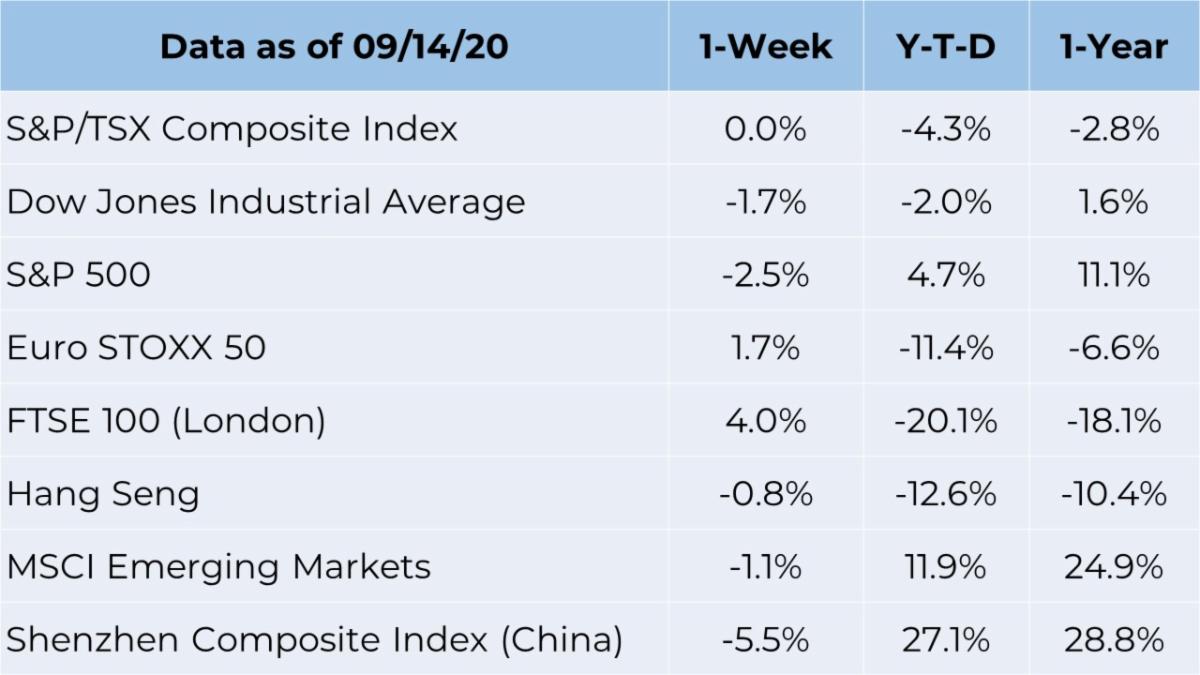Weekly Market Commentary September 17 2020
The Markets
Last week, the Nasdaq Composite Index set another record.
So far, 2020 has been memorable for many reasons, not the least of which is the incredible speed at which some events have been occurring in financial markets. This year, we’ve experienced:
- The end of the longest bull market in history
- A global stock market crash
- The shortest bear market in history
- Multiple record highs for major stock indices
Last week, we witnessed the swiftest correction on record as the Nasdaq fell by 10 percent in just three days. By the end of the week, the Index had recouped some losses and finished down 4.1 percent. The S&P 500 index and Dow Jones Industrial Average also finished the week lower, while the S&P/TSX Composite index remained more-or-less flat.
It would be gratifying if the recent drop in share price steadied stock markets. However, we are likely to see stocks remain volatile through the end of 2020. The Economist explained:
“Because of the influential role of turbocharged retail investment, prices can be expected to remain choppy. Moreover, the market is entering a period where typical COVID-19-related volatility may be exacerbated by the twists and turns of America’s presidential election.
“That said, much of the tech recovery from the lows in March was rooted in fundamental shifts, like policy interventions, or pandemic-prompted changes to consumer behavior, such as online shopping, that have helped firms…Even if the giddy obsession with tech firms exhibited during the summer fades, there may be little reason for investors to throw in the beach towel yet.”
This is a good time to take a gut check and make sure your asset allocation aligns with your financial goals and your response to market volatility. If you have any concerns about your investment portfolio or current market events, please don’t hesitate to give us a call.

Source: Refinitiv
Go fly a kite
Wind is one of the fastest growing energy sources in the world. In 2019, wind generated 7.2 percent of the electricity in the United States, powering 27.5 million homes, reported the American Wind Energy Association. Wind power produces more than 25 percent of the electricity in:
- Iowa, generating 41.9 percent of electricity
- Kansas, generating 41.4 percent of electricity
- Oklahoma, generating 34.5 percent of electricity
- North Dakota, generating 26.8 percent of electricity
Canada has also experienced rapid increases in wind power generation, growing at an average of 16 percent per year, currently sitting at around six percent of total generation, as per the Canadian Wind Energy Association.
As with many things, wind farms have pros and cons. On the plus side, wind energy is a renewable energy source that generates income and tax revenue in rural areas. In the negative column, construction can damage drainage systems and hurt crop production. In addition, towering turbines can catch fire, throw ice, cause headaches (literally), and create other issues, reported Slate.
A new wind energy option may do away with some of those negatives in some locations. Wind kites deliver power and have a far smaller profile than many turbines. Fast Company explained:
“As the kite flies autonomously, driven by the wind, eight small onboard rotors turn and generate energy that is sent down a thin tether back to the ground…it does the same work as the tips of the blades on large wind turbines, which convert the most energy in the system because they move the greatest distance as they’re pushed by the wind. But the new technology, which came out of research at the Technical University of Munich, does that work without the same need for massive infrastructure.”
Wind kites may be well-suited to islands and other areas where importing turbines is not feasible. They may also be a sound option in hurricane-prone regions since kites can be lowered to the ground. Best of all, kites use 10 times less material, so costs are significantly reduced.
Weekly Focus – Think About It
“We are moving so fast that when plans are being made to perform some great feat, these plans are broken into by a youth who enters and says, “I have done it.” This is exactly what Cook did for Arctic exploration.” (April 1914)
--Elbert Hubbard, Writer and publisher
Best regards,
Eric Muir
B.Comm. (Hons.), CIM®, FCSI
Portfolio Manager
Tracey McDonald
FCSI, DMS, CIM®
Portfolio Manager


